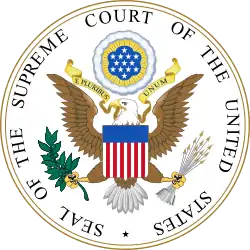United States v. Bagley
United States v. Bagley, 473 U.S. 667 (1985), was a Supreme Court of the United States case that established the standard for materiality under Brady v. Maryland.
| United States v. Bagley | |
|---|---|
 | |
| Full case name | United States v. Bagley |
| Citations | 473 U.S. 667 (more) |
| Case opinions | |
| Majority | Blackmun, joined by Warren, Clark, Brennan, Stewart, Goldberg |
| Concurrence | White, joined by Burger, Rehnquist |
| Dissent | Marshall, joined by Brennan |
| Dissent | Stevens |
| Laws applied | |
| U.S. Const. amend. XIV | |
Background
Brady and its progeny
In Brady v. Maryland (1963), the Supreme Court held that the prosecution must disclose all exculpatory evidence to the defense. The only requirements being that the evidence is favorable to the defendant and material.[1]: 4 Thirteen years later, the Supreme Court defined what it meant for evidence to be material in a case called United States v. Agurs (1976).[2] In Agurs, the Court set two different standards of materiality based on whether or not the defendant requested the nondisclosed evidence.[2]
Facts of the case
After being indicted on 15 charges of violating federal narcotic and firearm statutes, Hughes Bagley's counsel filed a discovery motion that requested information on the witnesses the prosecution intended to call, their criminal records, and any promises made to them in exchange for testimony.[3] At Bagley's bench trial, two state law-enforcement officers testified as the prosecution's principal witnesses. The prosecution did not notify the defendant of any promises made to them in exchange for testimony, as required.[3] Mr. Bagley was subsequently found guilty of all the narcotics charges but not guilty for all of the firearms charges.[4]
In 1980, while incarcerated for the narcotic charges, Bagley filed a Freedom of Information Act request and received response copies of ATF contracts that the principal witnesses had signed three years prior.[4] These forms were entitled "Contract for Purchase of Information and Payment of Lump Sum Therefor" and indicated $300 was to be paid to the witnesses. Each form stated that the principal witnesses would:[4]
[P]rovide information regarding T–I and other violations committed by Hughes A. Bagley, Jr.; that he will purchase evidence for ATF; that he will cut [sic ] in an undercover capacity for ATF; that he will assist ATF in gathering of evidence and testify against the violator in federal court.
Bagley moved to vacate his sentence under Brady v. Maryland, arguing that his right to due process had been violated by the prosecution's failure to disclose these forms.[4] The district court ruled against Bagley but was reversed by the Ninth Circuit.[4]
Opinion of the court
Part III
Only Justices Harry Blackmun and Sandra Day O'Connor signed onto Part III of the majority opinion where they adopted the Strickland v. Washington standard for prejudicial deficient performance by counsel as the new standard for materiality under Brady.[2] Under that standard, nondisclosed evidence is material if it has a "reasonable probability" to alter the trial result.[2] By doing so, the opinion framed the standard as flexible enough to cover previous scenarios where the defendant requested or did not request the evidence in question.[2] The opinion further defined "reasonable probability" as "a probability sufficient to undermine confidence in the outcome."[5]
The Blackmun opinion permitted trial courts to make an additional inquiry in specific request cases (i.e., when the defendant asked for the nondisclosed evidence specifically), to determine whether the defendant's case was adversely affected by the withholding.[6]
White concurrence and Marshall dissent
Justice Byron White wrote a concurrence that was joined by Chief Justice Warren E. Burger and Justice William Rehnquist.[3] The three signed onto the new "reasonable probability" standard discussed in Part III but did not join the Blackmun opinion's statements regarding specific requests.[3]
Justice Thurgood Marshall wrote the dissent, joined by Justice William J. Brennan Jr.[3]
Scholarly criticisms
Bagley has been criticized by scholars for requiring prosecutors to make disclosure decisions based upon their post-hoc view of how the trial will go.[7][8] Gerald Fowke stated that "[t]he chasm between 'a reasonable probability' and 'sufficien[cy] to undermine confidence in the outcome' cannot be bridged by defining the former with the latter" because probabilities are objective, and confidence is subjective.[7]
References
- Criminal Law: Cases and Materials, 7th ed., 2012, Wolters Kluwer Law & Business; John Kaplan, Robert Weisberg, Guyora Binder, ISBN 978-1-4548-0698-1
- Nofer, PG (1986). "Specific Requests and the Prosecutorial Duty To Disclose Evidence: The Impact Of United States V. Bagley". Duke Law Journal. 35: 892.
- United States v. Bagley, 473 U.S. 667, 669-70 (1985).
- Bagley, 473 U.S. at 671-72.
- Bagley, 473 U.S. at 682.
- Emily D. Quinn, Standards of Materiality Governing the Prosecutorial Duty to Disclose Evidence to the Defense, 6 Alaska L. Rev. 147, 158 (1989)
- Gerard Fowke, Material to Whom?: Implementing Brady's Duty to Disclose at Trial and During Plea Bargaining, 50 Am. Crim. L. Rev. 575, 595 (2013).
- Jordan Chemtob, Foul Blows: Using the Ethical Standard to Prevent Low-Level Brady Violations from Slipping Through the Cracks, 34 Geo. J. Leg. Ethics 807, 815 (2021).